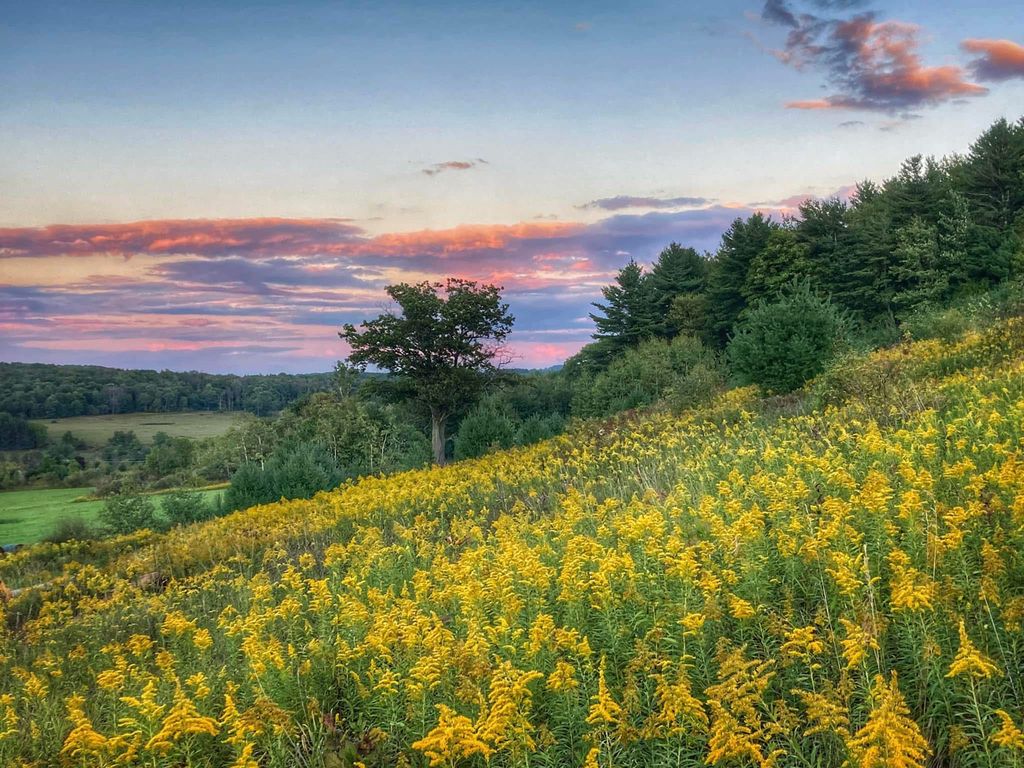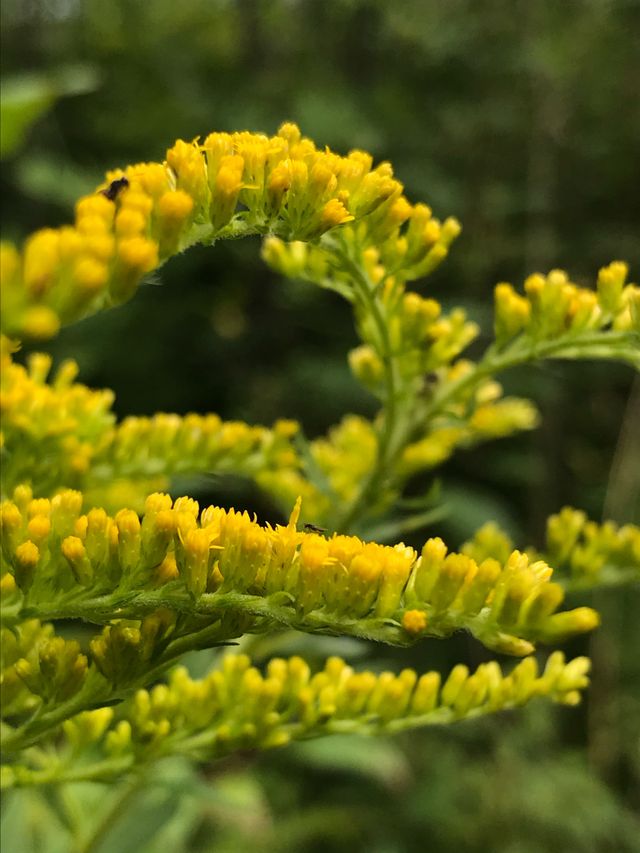
The foliage is growing old;
All through the verdure gleams the gold;
The rose is turning into mold;
But golden rod stands ev’rywhere.
Excerpt from “The Golden Rod” by Samuel Alfred Beadle
When the summer heat begins to give way to cool nights, waves of goldenrod (Solidago spp.) blooms erupt in fields, meadows, roadsides, and gardens that tend towards the wild and free. Nodding gracefully while all at once appearing as a firework, goldenrod is the star of the late summer native flower parade. Small yellow-gold flowers grow in panicles along strong central spikes above narrow foliage. Some species hold these flowers in a central spike, like the narrow or coastal goldenrod (Solidago spathulata), while the showier species, such as Canada goldenrod (Solidago canadensis) are made up of several arching sprays along a tall, central stem.
Goldenrod is easily grown in full sun to part shade, tolerating various soil and moisture conditions, with little to no serious pest issues. There are more than 130 Solidago species throughout the world, and approximately seventy-five known to be native in North America. Two dozen goldenrod species are native to the state of New York. This herbaceous perennial is a late-season pollinator favorite, providing nectar and pollen to the migrating Monarchs and many native bees and insects after the first frosts severely limit foraging options.
The goldenrod genus is rich not only in color, form, and extensive world population, but also in history and culture. The botanical name of the genus, Solidago, is derived from two Latin words, solida, which means “whole,” and ago, “to make,” referring to the many ways several species have been used for healing by different cultures, dating back to the ancient Greeks. Native American tribes used goldenrod as a poultice to treat external wounds and sores for humans as well as horses. Infusions were also made for a wide range of internal ailments, including fevers, pain, and as a sedative.*
In many cultures, goldenrod flowers are a symbol of abundance and wealth. They are often associated with prosperity and are believed to bring good fortune to those who possess them. In ancient Greece, for example, goldenrod was dedicated to the Greek god of wealth, Plutus, and was believed to attract financial success. In some Native American traditions, goldenrod is a symbol of protection and healing, believed to ward off negative energy and bring positive vibes where it grew. The Navajo used it as a good luck charm for gambling, and other tribes used its flowers in ceremonies. A few legends associated with goldenrod are the belief is that if goldenrod grows near a house, its occupants will have good fortune. Another legend states that wherever goldenrod grows there can be found buried treasure.
In Victorian England flowers were given as gifts, and often a message was conveyed by the meaning associated with the flowers in the bouquet. Goldenrod flowers conveyed encouragement and support, often given as a gift to uplift spirits and provide comfort during challenging times. The vibrant yellow flowers were seen as a representation of optimism and hope.

While possibly not covered in your fourth-grade civics class, goldenrod is significantly woven into United States history. After the Boston Tea Party, the infamous dumping of imported tea into Boston Harbor to protest British taxation, the colonists had to find native alternatives for their favorite hot beverage, and goldenrod leaves were the first plant to be brewed as a substitute. Goldenrod tea became known as “Liberty Tea” and for a time it was the exclusive choice for tea leaves in the U.S. colonies.
In the early twentieth century, goldenrod was a frontrunner for the U.S. national flower. Among its competition were columbine, clover, and daisy. Unfortunately, its wrongful reputation as the cause of hay fever may have prevented it from receiving such an honor. The national flower debate continued into the 1980s, long after its inconspicuous growing companion ragweed (Ambrosia spp.) was discovered to be the true hay fever–causing culprit. While goldenrod may have lost out to the rose for the title of National Flower, in 1926 it became the state flower of Kentucky. Solidago gigantea, commonly called giant or early goldenrod, both graces the Kentucky state flag and encircles the state seal.
You’ve heard of Goodyear tires—but how about goldenrod tires? Inventor Thomas Edison experimented with goldenrod’s natural rubber properties. Edison began his search for native plants to source for rubber in the 1920s, with the possible threat of imports from Southeast Asia and the East Indies being cut off. He experimented with a variety of plants at his Fort Myers, Florida, and West Orange, New Jersey, laboratories, and goldenrod proved most promising. He was able to cultivate a twelve-foot-tall plant that yielded as much as twelve percent rubber content. Henry Ford gave Edison a Model T with tires made from goldenrod, but, unfortunately, Thomas Edison died before his project went into commercial production. During World War II there was extensive process development conducted on goldenrod to commercialize it as a source of rubber. However, none were as successful as Edison’s, as they could only cultivate leaves with a rubber content of seven percent. The rubber had a low molecular weight, resulting in an excessively tacky compound with poor abilities to be stretched.
That is quite a lot of history, but let’s not forget the tactile and artsy of us out there. If you are looking for an easy art project, look no further than gathering some goldenrod inflorescence and a piece of fabric that needs enlivening. The yellow-gold flowers can easily be used as a dye on their own for a sunshiny hue or combined with the blue flowers of Baptisia (False Indigo) to create shades of green. So the next time you take a late summer stroll and see the golden waves in all their glory, enjoy them for what they are, a bright, robust native pollinator plant, and think on all they have been and could be. Liberty tea and afternoon tie-dyeing anyone?
Bonnie Warriner is a horticulturist and budding flower farmer with a love for capturing beauty in pictures and words. You can find her among the wildflowers and goats on her family’s 150-acre farm in Jasper, New York.
Want to try dying fabric with goldenrod? See our September/October 2022 issue for directions. The full issue is available at upstategardenersjournal.com.
This article originally appeared in the July/August 2025 issue of Upstate Gardeners’ Journal.
Views: 15






